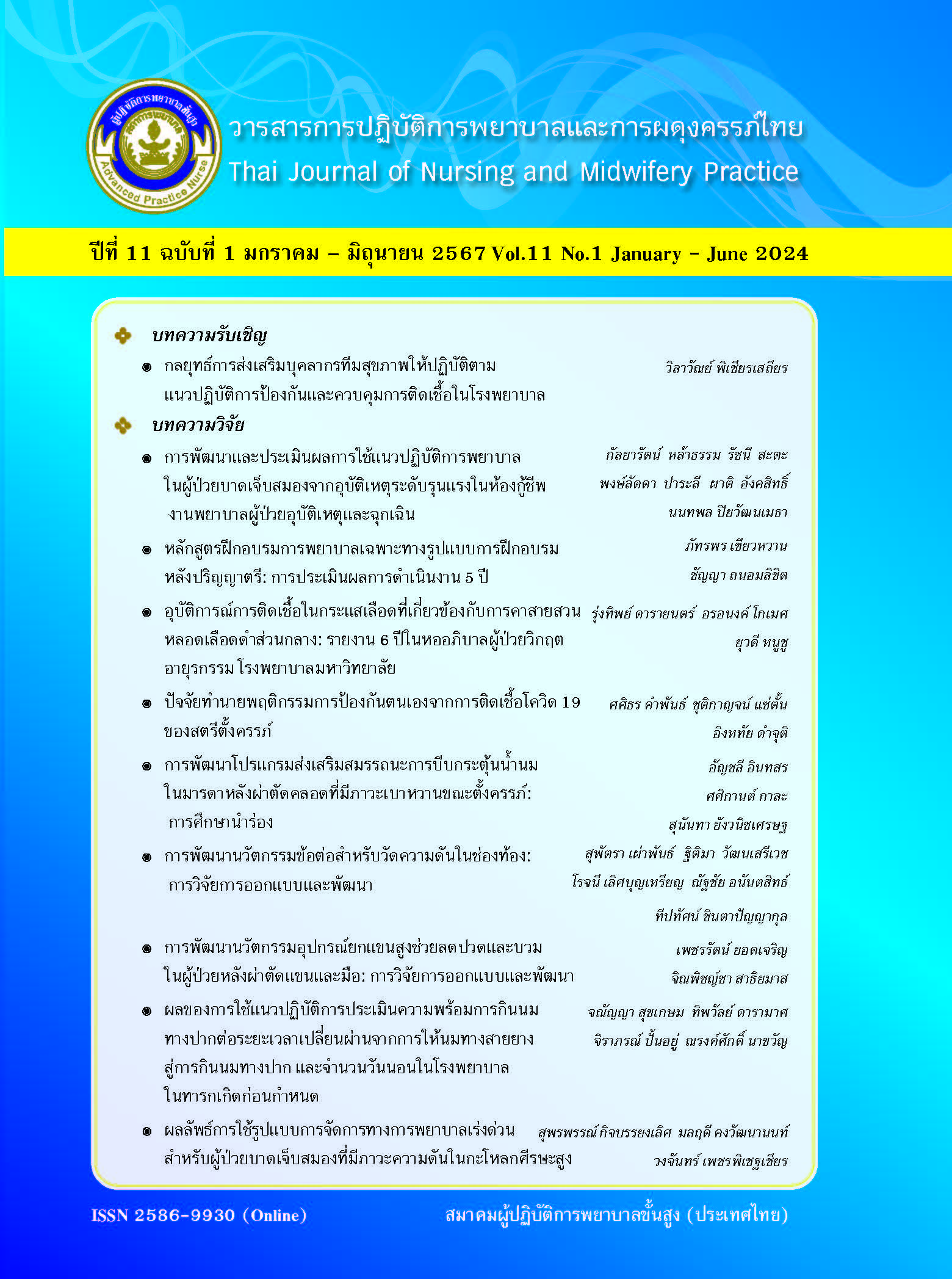Effects of Implementing an Oral Feeding Readiness Assessment Guidelines on Transition Time from Tube to Oral feeding and Length of Stay in Preterm Infants
Main Article Content
Abstract
This research adopted a quasi-experimental design to explore the effects of using oral feeding readiness assessment guidelines on the transition time from tube to oral feeding and length of stay in preterm infants admitted in the Neonatal Intensive Care Unit (NICU) and sick newborn at a tertiary hospital. Purposive sampling was performed to recruit 42 preterm infants. Subjects were assigned to an experimental group to receive oral feeding readiness assessment based on guideline (n = 21) or to a control group to receive routine nursing care for oral feeding (n = 21). The instruments included oral feeding readiness assessment guidelines developed from evidence synthesis and oral feeding readiness assessment, feeding volume and time, and vital signs. The data were analyzed using Chi-square test and Independent t-test. The results revealed that the mean transition time from tube to oral feeding and the mean length of stay in the experimental group were significantly less than those in the control group (t = 4.04, p = .00), (t = 2.08, p = .04) respectively. The results suggest that oral feeding in preterm infants can be started at less than 34 weeks. Using guidelines for assessing the readiness for oral feeding can help nurses make appropriate decisions to start oral feeding earlier in premature infants and achieve recognized standards in nursing practice.
Downloads
Article Details

This work is licensed under a Creative Commons Attribution-NonCommercial-NoDerivatives 4.0 International License.
References
Weeks CL, Marino LV, Johnson MJ. A systematic review of the definitions and prevalence of feeding intolerance in preterm infants. Clin Nutr. 2021;40(11): 5576-86. doi: 10.1016/j.clnu.2021.09.010.
Fry TJ, Marfurt S, Wengier S. Systematic review of quality improvement initiatives related to cue-based feeding in preterm infants. NWH. 2018; 22(5): 401-10. doi: 10.1016/j.nwh.2018.07.006.
Davidson E, Hinton D, Ryan-Wenger N, et al. Quality improvement study of effectiveness of cuebased feeding in infants with bronchopulmonary dysplasia in the neonatal intensive care unit. JOGNN. 2013; 42(6): 629-40. doi: 10.1111/1552-6909.12257.
Kirk AT, Alder SC, King JD. Cue-based oral 69 clinical pathway results in earlier attainment of full oral feeding in premature infants. J Perinatol. 2007; 27(9): 572-8. doi: 10.1038/sj.jp.7211791.
Lubbe W. Clinicians guide for cue-based transition to oral feeding in preterm infants: An easy-to-use clinical guide. J Eval Clin Pract. 2018; 24(1): 80-8. doi: 10.1111/jep.12721.
Ludwig SM, Waitzman KA. Changing feeding documentation to reflect infant-driven feeding practice. NAINR. 2007; 7(3): 155-60. doi:
1053/j.nainr.2007.06.007.
Gelfer P, McCarthy A, Spruill CT. Infant driven feeding for preterm infants: Learning through experience. NAINR. 2015; 15(2): 64-7. doi: 10.1053/j.nainr.2015.04.004.
Messer LL. Infant-driven feeding vs. scheduled feeding: the effect on hospital length of stay. [dissertation]. Minneapolis, Walden University; 2016. 72 p.
Wellington A, Perlman JM. Infant-driven feeding in premature infants: A quality improvement project. Arch Dis Child Fetal Neonatal Ed. 2015; 100(6): F495-50. doi: 10.1136/archdischild-2015-308296.
Swant L, Fairchild RM. Placing the bottle or breast in their premature hands: a review of cue-based feeding research. JNN.2014; 20(3): 122-8. doi: 10.1016/J.JNN.2013.09.003.
Lucus RF, Smith RL. When is it safe to initiate breastfeeding for preterm infants? Adv Neonatal Care. 2015; 15(2): 134-41. doi: 10.1097/ANC.0000000000000167.
Newland L, L’Huillier MW, Petrey B. Implementation of cue-based feeding in a level III NICU. Neonatal Netw. 2013; 32(2): 132-7. doi: 10.1891/0730-0832.32.2.132.
Gennattasio A, Perri EA, Baranek D, et al. Oral feeding readiness assessment in premature infants. MCN. 2015; 40(2): 96-104. doi: 10.1097/NMC.0000000000000115.
Kish M. Oral feeding readiness in preterm infants: A concept analysis.Adv Neonatal Care. 2013; 13(4): 230-7. doi: 10.1097/ANC.0b013e318281e04e.
Fujinaga CI, Zamberlan NE, Rodarte MD, et al. Reliability of an instrument to assess the readiness of preterm infants for oral feeding.Pro Fono. 2007; 19(2): 143-50. doi: 10.1590/s0104-56872007000200002.
Crowe L, Chang A, Wallace K. Instruments for assessing readiness to commence suck feeds in preterm infants: effects on time to establish full oral feeding and duration of hospitalisation. Cochrane Database Syst Rev. 2016; 2016(8): CD005586. doi: 10.1002/14651858.CD005586.pub3.
Griffith TT, Bell AF, Vincent C, et al. Oral feeding success: a concept analysis.Adv in Neonatal Care.2019; 19(1): 21-31. doi: 10.1097/
ANC.0000000000000540.
Tubbs-Cooley HL, Pickler RH, Meinzen-Derr JK. Missed oral feeding opportunities and preterm infants’ time to achieve full oral feedings and neonatal intensive care unit discharge. Am J Perinatol. 2015; 32(1): 1-8. doi: 10.1055/s-0034-1372426.
Foster JP, Psaila K, Patterson T. Non nutritive sucking for increasing physiologic stability and nutrition in preterm infants.Cochrane Database Syst Rev. 2016; 10(10): CD001071. doi: 10.1002/14651858.CD001071.pub3.
Samane S, Yadollah ZP, Marzieh H, et al. Cue-based feeding and short-term health outcomes of premature infants in newborn intensive care units: a nonrandomized trial.BMC Pediatr.2022; 22(1): 23. doi: 10.1186/s12887-021-03077-1.
Committee on Fetus and Newborn, American Academy of Pediatrics. Hospital discharge of the high risk neonate. Pediatrics. 2008; 122(5): 1119-26. doi: 10.1542/peds.2008-2174.


